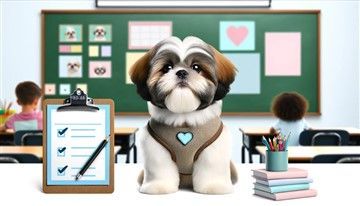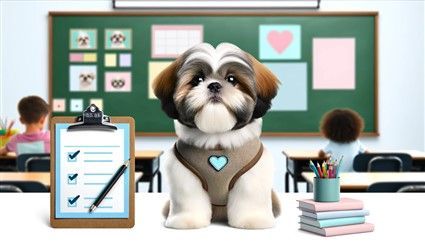Shih Tzu Training Tips
Overview
There are many types of training that you'll implement as your Shih Tzu grows and matures, ranging from housebreaking to socialization to commands. And just when you think all lessons are learned, an issue may pop up, like refusal to eat or barking and you'll have to reach for those training treats again. But, we have you covered.
This section covers: Shih Tzu Training Tips, which is a great place to start. We go over the fundamentals that are needed for just about every type of training you'll take on.
And for more specifics: Look to our Related Training Articles, that will lead you to exact step-by-step instructions for many types of training for your Shih Tzu puppy or dog.
Please note: AllShihTzu is reader-supported, and some of the product suggestions on this page are affiliate links. As an Amazon Associate we earn from qualifying purchases. This is at no extra cost to you and helps keep this site running.
Training Tips: Overview
Tip #1- Correctly Mark the Moment
For just about every type of training you will do with your Shih Tzu, there are fundamental guidelines that will help you be a good teacher, which in turn allows your little guy or gal to be a good student. Here, we go over these basic yet important aspects. It's recommended to have these down pat before you start any sort of training.
Tip #1 Use Positive Reinforcement:
Positive reinforcement is a cornerstone method in dog training, centered around the idea of rewarding desired behaviors to encourage their repetition. This approach is grounded in the psychology of learning, which suggests that behaviors followed by positive outcomes are more likely to be repeated.
In the context of coaching a dog to learn something new, positive reinforcement involves recognizing and rewarding your Shih Tzu's good behavior with something they value: Training treats and praise. The importance of this method lies in its ability to foster a positive relationship between you (as the trainer) and your Shih Tzu (as the student) without the use of fear or punishment.
The overall method of positive reinforcement is about creating an encouraging environment where a dog feels motivated to learn. It makes teaching skills more enjoyable. And when done correctly, it's a powerful tool for shaping behavior and actions.
Tip#2 Choose the Correct Type of Training Treats:
Training treats are a crucial element, no matter what lessons you are working to instill, acting as both a reward and a communication tool between a trainer (you) and dog (your sweetie-pie). They effectively motivate and encourage dogs to perform desired behaviors by providing a clear, immediate incentive. This not only speeds up the learning process but also deepens the bond between the dog and their trainer.
For training treats to work to their best, they must be seen as high-value to a dog, along with some other important aspects. They should be moist, packed with flavor, small (since a lot may be handed out consecutively) and never something that is normally given as a regular snack.
There are a couple all-natural, healthy options that we recommend. One is Wellness Soft Puppy Bites Treats. We love the made-in-the USA Wellness brand for many reasons, including their use of spearmint and other natural ingredients instead of artificial preservatives, their use of wholesome foods and their knack for offering much-loved flavors. This one is lamb & salmon, a winning combination for training.
Another favorite is Zukes Mini Naturals Soft Dog Treats, which are great for Shih Tzu dogs 1 year and up. These are also all-natural and made in the USA, with powerful packs of flavor in each little treat. This particular one is beef, as meat is a strong motivator for many dogs and they offer salmon and peanut butter options as well.
Tip#3 Offer Specific Praise to Reinforce the Behavior:
Praise is a fundamental aspect of teaching a dog, serving as a verbal reward that enhances the effectiveness of positive reinforcement. When used correctly, praise not only motivates a dog but also strengthens the emotional connection between a dog and their trainer.
Including specific commands within the praise, such as "good sit" instead of just "good," helps a Shih Tzu understand exactly which behavior is being rewarded. This specificity in praise makes the learning process more clear and efficient, allowing a Shih Tzu to quickly associate their actions with positive feedback.
Tip#4 Correctly Mark the Moment:
This technique involves giving the reward and praise at the exact moment your Shih Tzu performs the desired or requested action or behavior, providing a clear signal of what is being rewarded. By doing so, you help them make a direct connection between the behavior and the positive outcome, which is crucial for effective learning. This immediate feedback loop encourages quicker learning and adaptation, as it taps into the dog's natural desire to please and receive rewards.
To implement this, be sure you have the treats on you, in a zipped sandwich bag or training treat bag, as opposed to having to search for them.
Tip #5 Implement Repetition:
Tip #6 Maintain Consistency:
Consistency is the partner to repetition in the realm of dog training, acting as the cornerstone for effective learning and behavior modification. While repetition ensures that a Shih Tzu is exposed to a command or behavior multiple times to understand and memorize it, consistency guarantees that the learning is uniform and steady. This means using the same commands, cues, and rewards each time, so your little guy or gal does not become confused about what is expected.
Consistency also includes your tone of voice and body language. By maintaining a consistent approach, you can make it easier for your Shih Tzu to understand the link between a specific behavior and its outcome.
Tip #7 Have Realistic Expectations:
While the Shih Tzu breed can be intelligent, clever and loyal with a strong aim to please their humans, it's important to have realistic expectations. Learning new behaviors or actions is a process that varies greatly among individual dogs, so it's best to not compare your little guy or gal's progress with any other dog.
As long as you follow training guidelines, rest assured that your Shih Tzu is doing the best they can, at their own pace. Keep training fun and non-stressful by balancing patience, consistency, and an appreciation for your Shih Tzu's current learning phase, ensuring progress is celebrated at every step, no matter how small.
Tip #8 Teamwork:
Related Articles:
Below is a list of our training advice, from traditional training like housebreaking to addressing behavioral issues like picky eating. This is in alphabetical order, for your convenience.
Barking. This article covers barking issues, including why Shih Tzu puppies and dogs bark, common triggers, and exact step-by-step training to help stop excessive vocalization: Shih Tzu Barking.
Begging. If your Shih Tzu constantly begs for food with those puppy-dog eyes and you're having trouble not giving in, this article is for you. This includes common begging behaviors, along with specific guidance to address it: Shih Tzu Begging Behavior.
Chewing. This article covers the topic of chewing on non-toy items and includes aggressive chewing tendencies including the destruction of your personal belongings. See how to effectively resolve this: Shih Tzu Destructive Chewing.
Coprophagia (aka eating feces). This is a bad habit that should be addressed right away. Read why dogs do this, what sort of health issues it can cause and exact, detailed steps to stop this behavior: Shih Tzu Coprophagia.
Eating Things off the Ground. If your Shih Tzu likes to forage around outside, picking up all sorts of things in their mouth, to munch or ingest, follow these guidelines to help keep your little guy or gal safe: Shih Tzu Eating Things Off the Ground.
Growling. The Shih Tzu breed is generally very friendly and docile, so aggressive behavior like growling is rare. However, if this is occurring, it should not be ignored. See why a Shih Tzu may growl and how to react: Shih Tzu Growling.
Heeling. If you train your Shih Tzu to heel, walks can be more enjoyable. And as a bonus, heeling encourages your dog to see you as a leader, which can domino into much better behavior at other times: How to Train a Shih Tzu to Heel.
House Training. This is the one type of training that nearly every pet parent must do with their Shih Tzu. Read our step-by-step guidelines for effective, successful housebreaking. This is for puppies and for older dogs that need some reminders: Shih Tzu House Training.
Humping. This is a behavior that both females and males may display, though it is more common in un-fixed males. Dogs may hump toys, pillows, and other household objects, in addition to trying to hump other dogs. See why Shih Tzu dogs do this, why addressing it is important and exactly how to react: Shih Tzu Humping Behavior.
Licking People. While it's always nice to get some puppy kisses, in some cases a Shih Tzu can get very carried away and start to constantly like their human in an obsessive way. See how to deal with this behavior, in a loving way: Shih Tzu Licking People.
Licking Non-toy Objects. Shih Tzu puppies and dogs may also develop a habit of excessively licking non-toy objects in and out of the home. This can be due to behavioral issues or, in some cases, health issues. Learn more about this: Shih Tzu Licking Non-Toy Objects.
Jumping Up on People. This is often done out of pure excitement and while there is nothing fundamentally wrong with this, if your Shih Tzu is jumping on little kids, visitors to your home or other people that you find to be inappropriate, there are some techniques that can stop this behavior: Shih Tzu Jumping Up on People.
Marking, Territorial Marking. This can be a trying behavior that should be dealt with as soon as it begins. See why Shih Tzu dogs may do this and step-by-step training to immediately address this: Shih Tzu Territorial Marking.
Nipping, Biting. This article address nipping, which is a common behavior with young Shih Tzu puppies and also looks at the difference between nipping and biting: Shih Tzu Nipping and Biting.
Picky Eaters. This article covers the common issue of a Shih Tzu being overly finicky and turning up their nose at foods, no matter what you do. If your little guy or gal can't seem to make up their mind about what they like or have very limited taste, this guide is for you: Shih Tzu Picky Eating.
Rolling in Poop. This is an odd behavior that canines may display and there are several theories on why they do this. But regardless of the underlying cause, these tips will help you control this behavior: Shih Tzu Rolls in Poop.
Stubbornness. This breed is known for having a bit of an independent streak, which is fine in and of itself. However, if your Shih Tzu is exceptionally headstrong, these guidelines will get things back on track: Shih Tzu Stubborn Behavior.
Additional Related Article:





